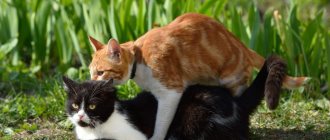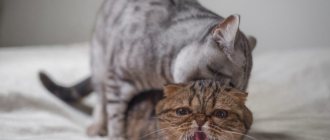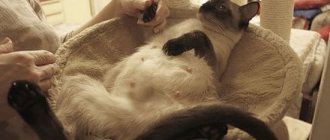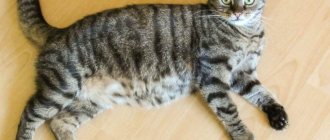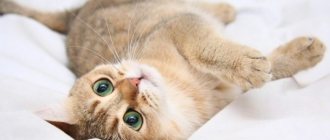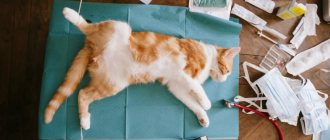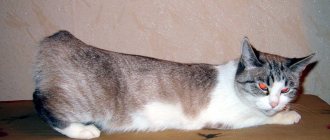The Bengal breed is the result of selective crossing of a domestic cat with an Asian leopard cat. In order for this breed to develop and improve, many obstacles were overcome. Now the personality of the representatives of this breed is predictable and beautiful kittens are born - the future successors of the elite breed.
Bengal cat standards
The central characteristic of the standard of this breed is the wild color - the result of the breeders' desire to preserve as much as possible of the leopard cat's appearance:
- Bengals can be any color from the brown tabby palette, but orange tones in color are most valued. The base color of the coat can be cream, golden, grayish, golden, or rufus.
- The spots may be brown or black, like a leopard's, and may also include a hint of chocolate.
- The area of the whiskers, belly, chin and between the hind legs should be white or another light tone. On the back and sides the color is darker to enhance contrast. There is a black outline around the nose and eyes.
- The mucous membrane has a brick tint.
- The tip of the tail and paw pads are black.
The body of the British cat is strong and long, has a powerful skeleton and a muscular neck. Compared to most domestic fluffies, this breed is characterized by a fairly large weight - cats can weigh up to nine kilograms, females - from five to seven.
The head of the British is wedge-shaped - it is wide and rounded. At the same time, the width of the jaw is quite large. The profile has a slightly concave forehead, the nose is wide and large. Massive mustache pads give the impression of being swollen, the cheekbones are characterized as noticeable and quite high. The ears are set high, have rounded tips and a wide bottom. The outer side of the ears has light spots. Almond-shaped eyes can be any color - from golden to green. The spotted tail is of medium length and appears dense. The strong hind legs are longer than the front legs and have a rounded shape.
The fine coat has an exquisite glossy sheen and beautiful spots covering the entire body. The main color of the fur coat can be white, red, or gray. Kittens have longer hair than adults. Overall, the original leopard-print exterior of the Bengal is incredibly beautiful - you can’t take your eyes off it!
Different and beautiful
The colors of Bengal pets are very diverse. They are distinguished by the color of their coat and the shape of the pattern, which can be:
- spotted or spotted;
- rosette or rosetted;
- marbled or marbled.
On the muzzle there are dark stripes on the sides, they fold on the forehead into the shape of the letter M. A scattering of small spots or stripes on the neck, the same markings should be on the light belly. The tail is covered with dark rings, the tip is dark.
Color brown/black tabby/spotted, i.e. a spotted/rosette pattern on a golden background is considered classic and the most popular. The color of the rosettes is chocolate, black, dark brown. The background color can be orange or yellow, clearly contrasting with the pattern. The belly, whisker pads, inner side of the paws, chest, and chin are lighter than the rest of the parts. The ginger kitten with dark spots looks like a real leopard, only small.
Dark marble pattern (brown tabby/marble) is another well-known color version. The stripes should be predominantly horizontal on light colored wool. Marble is equipped with a darker edging. But round stains, called “bull’s eyes,” are considered unacceptable.
An interesting variety of dark color is ash, also known as charcoal. Contrasting pattern on a light, cold background. There are “spectacles” around the eyes, and the eyebrows are black. This variety is not yet officially recognized, but is awaiting registration.
Silver tabby Bengals are very different from their dark brothers, but they look amazing. On a light silver background there are ash-gray/black stripes, rosettes, and spots. There is a black edging around the nose, as well as lips and eyes. The belly and inner sides of the paws are lighter than the main background. The color is darker on the back. The contrast requirements between the background color and the design remain unchanged.
Designation of Bengal colors
| Code | Color characteristics |
| BEN n 24 | Spot or rosette on a golden background |
| BEN n 22 | Marble on gold |
| BEN ns 24 | Spot or rosette behind silver |
| BEN ns 22 | Marble on silver |
| BEN n 33 | Seal Links Point |
| BEN n 32 | seal mink tabby |
| BEN n 31 | Seal sepia tabby |
| BEN n 24 charcoal | Black drawing on a light background, no brown or yellow tints, no code |
| BEN n 24 melanistic | Often black, but any background is acceptable, visually monochromatic, rosettes visible from a certain angle, not recognized |
| BEN a 24 blue | Blue-gray pattern on a light blue background, not recognized |
Separately, it is worth mentioning snow bengals, which come in three varieties:
- sepia;
- mink;
- color point.
Sepia is the darkest option with a light golden or orange background. The stripes are slightly darker than the background. The tip of the tail and the pads on the paws are chocolate. Mink is lighter, the background of this color varies from sable with a golden tint to cream. The contrast between the background and the pattern is not as noticeable as with the Browns.
Snow Bengal kittens of these two species are born almost white. Before phasing begins, the pattern is very weakly expressed. By the time of puberty, rosettes, stripes, and spots will become noticeable and clear. A touching white kitten will turn into a bewitching beauty with green or aquamarine eyes.
“The mink and sepia snow colors differ very slightly visually, but are formed by different genes. Genetic testing may be needed to accurately determine the type.”
Snow Bengals of the Lynx variety are color-pointed, have darker spots on the tail, paws, ears, muzzle, and the color of the body is lighter. The background is ivory or cream, very light, the eyes are blue. Snow lynxes are born pure white, the pattern will appear later, often only towards the end of the first year.
Blue Bengals are very rare beauties that have not yet been officially recognized. This doesn't stop them from looking great. On a cool blue-gray background with a metallic tint, the dark gray pattern looks unique.
Personality of Bengal cats
The appearance of the Bengal cat is associated with the leopard and is perceived as treacherous and aggressive. In fact, this is not at all the case - fluffy domestic leopards are good-natured and sociable, which, of course, cannot be said about their wild ancestors.
Bengals are extremely self-confident and independent, but obedient to their owners. These cats love people and truly enjoy being with their owners. If the owners are absent from home for a long time, the cat will think that it has been betrayed and abandoned - this can lead to the pet getting sick. The Bengali is suspicious of strangers, but he loves his owner and trusts him boundlessly. If you give him affection and love, you can get a hundred times more in return.
Representatives of this breed are playful and curious - they tirelessly walk around the house in search of adventure. Play is of particular importance for her, because physical activity is vital for this cat. This is why Bengalis have vertical obstacles installed in their homes.
Bengalis are extremely intelligent. They can be taught simple commands - for example, “take a toy” or “sit”. Most cats easily learn to use their owners' toilets - experts say this ability is explained by the habit developed by their ancestors, who urinated in bodies of water so as not to leave a smell.
Bengal cats are not only not afraid of water, but even love it - they often express a desire to help their owner wash the dishes by jumping into the kitchen sink, or to keep company in the shower. The leopard is famous for its fishing abilities, so its domestic relatives strive for water, realizing part of their instinctive desire to catch fish for food. These beautiful creatures also try to realize their other instincts - for example, to hunt. They love hunting and try to do it always and everywhere. In general, it is vital for Bengals to realize their wild natural energy, and ignoring this condition can lead to the appearance of psychological problems in the animal.
What makes the Bengal unique is that the breed standard describes the ideal temperament. When an animal demonstrates any inconsistency with this ideal, it is disqualified - this is how the future of the breed is taken care of.
Why doesn't a Bengal kitten look like an adult Bengal? What is phasing?
A few words about what phasing is among Bengals. You've been waiting for this day for months! Today a new family member should appear in your home - a small spotted lump. Everything is already ready for his appearance: a cozy house has been bought, a comfortable scratching post has been waiting for its new owner,
a beautiful tray hidden in a cozy corner.
And now, the long-awaited moment has arrived - you have arrived at the breeder’s house to pick up the baby. And, oh horror!
Instead of a beautiful spotted “little animal” - a little leopard, they brought you a kitten that looked like one of those that you see every day in the company of barn cats. This is probably a scam. Instead of the Bengal kitten you have chosen, they are probably trying to “foist” you with a half-breed - a mestizo, or perhaps it is even a “choice” from the basement? Don't rush to jump to conclusions. Bengal kittens inherited from their wild ancestor, the Asian Leopard Cat or the small leopard, not only a spotted belly and a chic rosette coat, but also the heritage of their ancestors - “phasing” - a protective reaction of the growing body, the task of which is to shelter the babies from predators during the period when they begin to leave the lair and take their first steps in a hostile environment full of dangers. Remember those photos of wild cat cubs that you have repeatedly seen: cheetah cubs, covered with long gray hair, more reminiscent of wolf cubs than their handsome spotted parents. And small lion cubs, on the contrary, are covered with “leopard” spots, randomly scattered across the grayish skin and allowing them
hiding in the savannah among the sun's glare.
Kitten Harry at 4 months
The cubs of all wild cats are susceptible to phasing. And little Bengals are no exception here - phasing “covers” Bengal kittens at the age of 2-3 weeks and the first signs of “adult” color appear no earlier than four months. The long grayish hairs of the undercoat covering the bright coat will gradually fall out, never to appear again. Bengals never develop an undercoat during their lives, and Bengals will never shed seasonally. Be patient and the process of “cleaning” the Bengal skin
a kitten will give you many unexpectedly pleasant moments. Taking care of your own
"ugly duckling", you will watch his transformation into a beautiful "swan".
You are about to witness a unique process.
Every day, the spots hidden under the grayish-whitish hairs will become brighter and more contrasting. The kitten will increasingly resemble its spotted parents, and will increasingly resemble a “little leopard.” And finally, upon reaching 8-9, and sometimes 12 months, your Bengal will acquire the appearance of a spotted cat characteristic of this breed. And the pleasant moments that the kitten’s growing up period will give you will fully compensate for its “unsightly” appearance in adolescence. Bengal cubs are playful, active and, at times, very “comical” - real clowns. The way a little kitten explores the world around him, sticks his curious nose into every hidden corner, into every box and fearlessly climbs into any package.
will bring a smile to your face more than once.
So, don't be afraid of phasing - it's not a disease or a scam.
This is a normal development process for a Bengal kitten and only age can “heal” the baby. Just be patient and you will get
the kind of pet you've always dreamed of. And in order not to make a mistake in choosing a pet, buy it only in a nursery where you can meet the baby’s parents. In the animation on our website exotic-family.com you can see with your own eyes this transformation of the “ugly duckling” into a gorgeous beast.
PS The photo shows the same kitten Harry at the age of three and eight months
exotic-family.com
Glitter and phasing in Bengal kittens
So, you are ready to take the kitten home, you came to the breeder and see a baby of any breed, but not a Bengal. In fact, there is no deception here - the cat is in the phasing stage. This is the stage that leopards go through in the wild in order to blend into the surrounding landscape. After all, little leopard babies, leaving their home, find themselves in a world full of dangers. To protect them from numerous enemies, nature has provided a camouflage mechanism. Phasing affects children of all felines, and Bengals are no exception. This metamorphosis occurs at approximately three to four weeks of age in kittens. Upon reaching three to five months, the kitten’s skin is cleaned and begins to acquire that unique leopard color.
Glitter is another phenomenon associated with the appearance of the Bengal skin. This word is translated from English as “shine.” Glitter creates a shining effect - it seems that the cat's fur coat is sprinkled with gold sparkles. This effect is most clearly seen in sunlight. Cats with a predominance of brown tones have a warm gold glow. If the tones of the skin are silver, then the shine is cold metallic. The snow-white fur coat is decorated with pearl glitter.
Ticking and glitter
Some runners are characterized by ticking - coloring the hairs in several shades along the length. Sometimes this phenomenon causes some blurring of the picture. If the parents have low-contrast ticking of a gray or dark shade, the spots will not be very clear. There is a high probability that the kitten will inherit this feature.
Glitter, i.e. shine, not found in all Bengal cats. Individuals with a dark, brown color are characterized by a golden glow, while the coat of light-colored Bengals has a pearlescent or mica-like sheen. To win at exhibitions, glitter is not necessary. There is no such requirement in the breed standard. Bengals with matte fur look no less impressive. Character, upbringing, and intelligence are much more important.
“Bengal kittens are smart and curious. They actively explore a new home and any object that comes into their sphere of attention. Watching them grow up will bring many pleasant moments, regardless of color, glitter, or shape of spots.”
Appearance of Bengal cats
A true Bengali is a delightful sight! These animals create the illusion of real leopards, only in a smaller form. They have smooth fur, a muscular body, large bones, but at the same time incredible grace and swiftness. The Bengal's coat can have a variety of patterns, each with contrasting elements. The spots on the coat are an imitation of ordinary leopard spots, and the marbled pattern is an inheritance of the tabby gene.
What to feed Bengal cats
If a small leopard has settled in the house, the issue of its nutrition comes first, since the health of this cat directly depends on its diet and improper nutrition will cause a malfunction of the entire body. A domestic cat cannot take care of its own nutrition, so the responsibility lies with its owners. The food must contain everything necessary for the full functioning of the pet. Drawing up a nutrition plan for a Bengal cat is not an easy or responsible thing, so it is better to get advice from a specialist on this issue.
Bengalis should not be fed food that has not been eaten by humans. If you neglect this rule, you will have to, at best, treat your pet’s diarrhea, or visit a veterinarian for more serious problems. It is better not to talk about the worst-case scenario.
At least seventy percent of the total diet should be meat. The rest should include carbohydrates, fats and vitamins. To diversify the diet, you can give your cat offal. Bones with cartilage will also help, but only very small ones - ones that can be chewed.
Despite the stereotype, you cannot often feed your pets fish with fish, and this restriction especially applies to cats - frequent consumption of fish can cause urolithiasis. In moderation, you can give sea fish, from which you first need to remove the bones. Eating such food twice a week is quite acceptable.
Cats love egg yolks, so there is nothing wrong with occasionally treating your pet to quail eggs. This can be done no more than once or twice a week. Cats also love milk, but some of them may be intolerant to this product. When planning dairy products in your cat’s diet, you need to control their absorption by your pet’s body. As for fermented milk products, veterinarians do not recommend offering them to Bengals.
Store-bought food is quite appropriate for feeding a Bengal cat - it can be used either dry or canned. This breed has an increased sensitivity of the digestive tract, so unless absolutely necessary, you should not experiment by switching the animal from one type of food to another. The same applies to the transfer from store-bought food to natural food and vice versa. Dry and wet food must be of the same brand - you must pay attention to the composition of the product. A good food is one in which it is not soy or grains that predominate, but a meat component. Dry food is a must, as it is an excellent preventative against the formation of tartar. Two or three times a week is enough for variety. When choosing canned food, you also need to pay attention to the composition. Fat content above twenty percent is contraindicated for Bengal cats.
Clean water is a prerequisite for the healthy functioning of a cat’s digestive system - dehydration should never be allowed. Since representatives of this breed do not really like to drink from a bowl, you need to organize a special fountain for them, or provide them with the opportunity to drink from the tap.
How long do Bengal cats live?
Cats that have half wild and half domestic genes represent a very small percentage of all existing cat breeds. In the wild, Bengals live in the territory from Southeast Asia to the Far East and live very short lives - their age rarely reaches five years.
Their domestic relatives have a clear advantage in this matter. Provided they have loving owners, timely consultations with a veterinarian, a proper diet, and the opportunity to realize their energy, pet Bengals can live from twelve to fifteen years or even more.
Health and diseases of Bengal cats
Healthy parents, whose condition is controlled by breeders, produce offspring with strong immunity. In the process of working on this breed, a number of genetic anomalies were eliminated, while the genes of the wild, hardy Bengals remained. Despite their excellent natural characteristics, these cats are susceptible to some problems.
Before buying a Bengal kitten, you need to find out as much information as possible about its parents and cattery. It is not worth saving energy and time, since a lack of information can lead to a long, expensive and not always successful nursing of a kitten.
The main ailments of Bengalis
Bengals generally have good health, but there are still ailments that most often affect these cats.
- Poisoning with poor quality food, intestinal upset. These animals have a highly sensitive stomach and demonstrate a painful reaction to changes in food. In most cases, intestinal inflammation begins.
- Heart pathology – hypertrophic cardiomyopathy. This disease consists of a defect in the structure of the heart, when one of the walls is thicker. A malfunction of the heart can cause many health problems, including sudden death. The danger of this disease lies in the fact that it is quite difficult to diagnose it in a timely manner - it has virtually no early symptoms. Therefore, it is especially important for Bengalis to have an ECG and ultrasound of the heart.
- Disturbances in the functioning of the immune system. This problem is directly related to lines in which matings between close relatives occurred. It is important for these animals to undergo vaccinations and deworming procedures.
- Flat chest – this disease is only dangerous for kittens. This manifests itself in compression of the chest by the ribs and difficulty breathing. You cannot live with this defect, so if the kitten is alive, it will develop normally.
- Urolithiasis disease. This is especially true for animals that live in regions with hard water.
- Unsterilized cats may develop hormonal imbalances.
- Older pets face a high risk of cancer.
- Cats whose diet consists mainly of natural food suffer from tartar.
Careful monitoring of your pet's condition and timely examinations by a veterinarian will significantly reduce the risk of disease and give the cat many years of a happy, energetic life.
Care and maintenance
Bengal cats are easy to care for and are quite clean. It will be enough to comb them once a week. They do not require frequent bathing, although they will happily take a bath with you. In terms of hygiene: clean your ears from dirt in a timely manner. We advise you to immediately purchase a scratching post: despite trimming their claws, they will always want to sharpen them.
Your pet's tray needs special attention; it can be closed or with larger sides - they really love to rummage around in it. The Bengal breed has a sensitive sense of smell, so carefully monitor the contents a couple of times a day, otherwise the cat will simply go nearby. We also recommend not to use detergents with a strong pungent odor; after such cleaning, the pet may not recognize the tray. It is better to choose clumping wood filler.
For full maintenance, we recommend that from the first days you acquire a sufficient number of toys and, ideally, a high-quality play set. This way, you will protect your personal belongings, but you will have to get used to the desire to jump on shelves and closets.
How long Bengal cats live at home is 12-15 years, but a life expectancy of 20 years has been noted.
How much do Bengal cats cost?
How wonderful it is to come home and see how your faithful furry friend rejoices at your arrival! It is very easy to have an animal, but it is much more difficult to provide it with everything it needs for a happy life. Therefore, the solution to this issue must be approached with all responsibility - weigh all the arguments, think through all the details. If the decision has not changed, you can choose a breeder and prepare to meet your future pet.
Bengal cats that meet breed standards are considered elite. Therefore, the price for these kittens is appropriate. In Russia, the range of prices for this breed is quite large - from twelve to one hundred and twenty thousand rubles.
Conclusions about the breed
Bengal cats are an elite breed. They are graceful, elegant and have a magnificent sparkling coat with bright colors.
These animals are loyal and responsive - easily adapting to conditions at home, they never allow themselves groundless aggression. These cats are perfect for owners who are ready to devote enough attention to their pet, to be a sincere playmate and a companion on walks.
Bengalis are distinguished by great intellectual potential and sociability. They are characterized by cleanliness, love of comfort and goodwill. This breed receives high marks from experts at international exhibitions and is very popular among cat lovers all over the world. In a word - elite!
How to choose a pet
First you need to understand the purpose for which a new inhabitant will appear in the house. You can literally fall in love with a Bengal at first sight, the wild beauty of these cats is so amazing. Individuals that have been removed from breeding are usually taken into the family. Often, breeders spay or neuter before sale.
A high-class Bengal kitten intended for participation in exhibitions or breeding work will cost more. Such an activity will require a lot of time and effort, and it will be difficult to combine it with a full-time job and full-time care for one’s own family. Will the owner be able to provide everything needed? A sterilized Bengal will become a wonderful friend to children and will get along with other cats and dogs. When choosing the class of an animal, you need to be aware of the load that has arisen.
The purchase decision has been made, it’s time to move on:
- Choose a trusted nursery.
- Reserve a kitten.
- Make your home safe for your new pet.
- Purchase a tall play set, toys, drinking bowls, and feeding bowls.
- Meet a veterinarian who is willing to take care of your Bengal pet.
- Check with the breeder about the type of food, the brand of finished food, and the type of filler that the kitten is used to.
- Buy a convenient litter tray.
- Choose a place for feeding, lay a waterproof covering.
- Create a veterinary first aid kit.
The owner of a Bengal kitten must adjust his personal schedule. The new family member will need time to play and socialize every day. Outdoor walks need to be planned in advance. It is mandatory to use a harness and use medications that protect against ticks. Keeping a purebred Bengal is not easy, but he will give you a lot of joy and become a devoted friend.
